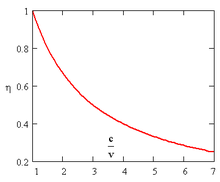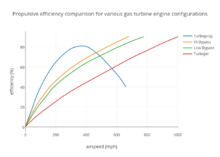Propulsive efficiency
In aircraft and rocket design, overall propulsive efficiency is the efficiency with which the energy contained in a vehicle's propellant is converted into kinetic energy of the vehicle, to accelerate it, or to replace losses due to aerodynamic drag or gravity. It can also be described as the proportion of the mechanical energy actually used to propel the aircraft. It is always less than one, because conservation of momentum requires that the exhaust have some of the kinetic energy, and the propulsive mechanism (whether propeller, jet exhaust, or ducted fan) is never perfectly efficient. Overall propulsive efficiency is greatly dependent on air density and airspeed.
Mathematically, it is represented as ,[1] where is the cycle efficiency and is the mechanical efficiency.
Cycle efficiency
Most aerospace vehicles are propelled by heat engines of some kind, usually an internal combustion engine. The efficiency of a heat engine relates how much useful work is output for a given amount of heat energy input.
From the laws of thermodynamics:
- where
- is the work extracted from the engine. (It is negative because work is done by the engine.)
- is the heat energy taken from the high-temperature system (heat source). (It is negative because heat is extracted from the source, hence is positive.)
- is the heat energy delivered to the low-temperature system (heat sink). (It is positive because heat is added to the sink.)
In other words, a heat engine absorbs heat from some heat source, converting part of it to useful work, and delivering the rest to a heat sink at lower temperature. In an engine, efficiency is defined as the ratio of useful work done to energy expended.
The theoretical maximum efficiency of a heat engine, the Carnot efficiency, depends only on its operating temperatures. Mathematically, this is because in reversible processes, the cold reservoir would gain the same amount of entropy as that lost by the hot reservoir (i.e., ), for no change in entropy. Thus:
where is the absolute temperature of the hot source and that of the cold sink, usually measured in kelvins. Note that is positive while is negative; in any reversible work-extracting process, entropy is overall not increased, but rather is moved from a hot (high-entropy) system to a cold (low-entropy one), decreasing the entropy of the heat source and increasing that of the heat sink.
Mechanical efficiency
Conservation of momentum requires acceleration of propellant material in the opposite direction to accelerate a vehicle. In general, energy efficiency is highest when the exhaust velocity is low, in the frame of reference of the Earth, as this reduces loss of kinetic energy to propellant.
Jet engines

The exact propulsive efficiency formula for air-breathing engines is [2][3]
where is the exhaust expulsion velocity and is the airspeed of the aircraft.
A corollary of this is that, particularly in air breathing engines, it is more energy efficient to accelerate a large amount of air by a small amount, than it is to accelerate a small amount of air by a large amount, even though the thrust is the same. This is why turbofan engines are more efficient than simple jet engines at subsonic speeds.

Rocket engines
A rocket engine's is usually high due to the high combustion temperatures and pressures, and the long converging-diverging nozzle used. It varies slightly with altitude due to changing atmospheric pressure, but can be up to 70%. Most of the remainder is lost as heat in the exhaust.
Rocket engines have a slightly different propulsive efficiency ( ) than air-breathing jet engines, as the lack of intake air changes the form of the equation. This also allows rockets to exceed their exhaust's velocity.
Similarly to jet engines, matching the exhaust speed and the vehicle speed gives optimum efficiency, in theory. However, in practice, this results in a very low specific impulse, causing much greater losses due to the need for exponentially larger masses of propellant. Unlike ducted engines, rockets give thrust even when the two speeds are equal.
In 1903, Konstantin Tsiolkovsky discussed the average propulsive efficiency of a rocket, which he called the utilization (utilizatsiya), the "portion of the total work of the explosive material transferred to the rocket" as opposed to the exhaust gas.[5]
Propeller engines

The calculation is somewhat different for reciprocating and turboprop engines which rely on a propeller for propulsion since their output is typically expressed in terms of power rather than thrust. The equation for heat added per unit time, Q, can be adopted as follows:
where H = calorific value of the fuel in BTU/lb, h = fuel consumption rate in lb/hr and J = mechanical equivalent of heat = 778.24 ft.lb/BTU, where is engine output in horsepower, converted to foot-pounds/second by multiplication by 550. Given that specific fuel consumption is Cp = h/Pe and H = 20 052 BTU/lb for gasoline, the equation is simplified to:
expressed as a percentage.
Assuming a typical propulsive efficiency of 86% (for the optimal airspeed and air density conditions for the given propeller design), maximum overall propulsive efficiency is estimated as:
See also
References
- Loftin, LK, Jr. "Quest for performance: The evolution of modern aircraft. NASA SP-468". Retrieved 2006-04-22.
- Loftin, LK, Jr. "Quest for performance: The evolution of modern aircraft. NASA SP-468 Appendix E". Retrieved 2006-04-22.
Notes
- ↑ ch10-3
- ↑ K.Honicke, R.Lindner, P.Anders, M.Krahl, H.Hadrich, K.Rohricht. Beschreibung der Konstruktion der Triebwerksanlagen. Interflug, Berlin, 1968
- ↑ Spittle, Peter. "Gas turbine technology" p507, Rolls-Royce plc, 2003. Retrieved: 21 July 2012.
- ↑ George P. Sutton & Oscar Biblarz, Rocket Propulsion Elements, pg 37-38 (seventh edition)
- ↑ "Study of Outer Space by Jet Drives", Nauchnoe Obozrenie, May 1903.